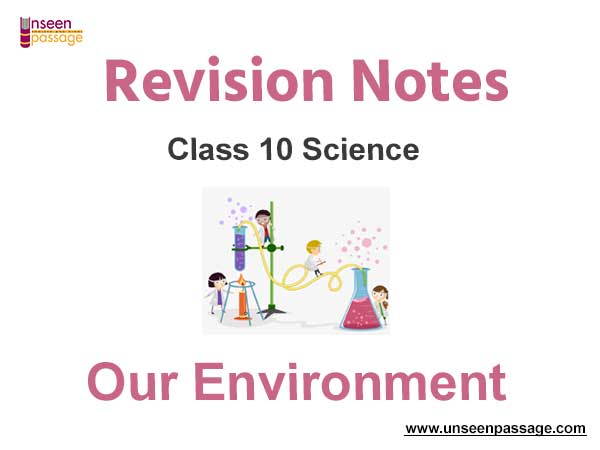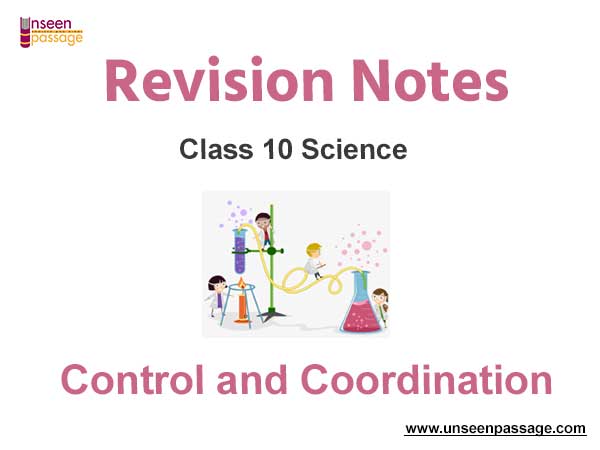Our Environment Notes for Class 10 Science
Following are Our Environment Notes for Class 10 Science. These revision notes have been prepared by expert teachers of Class 10 Science as per the latest NCERT, CBSE, KVS books released for the current academic year. Students should go through Chapter 15 Our Environment concepts and notes as these will help you to revise all important topics and help you to score more marks. We have provided Class 10 Science notes for all chapters in your book. You can access it all free and download Pdf.
Chapter 15 Our Environment Notes Class 10 Science
GIST OF THE LESSON/FLOW CHART

Environment: Our surrounding is called environment.
- Ecosystem and its components
- Biotic and abiotic components.
- Food chain and food web
- Energy transfer through trophic levels
- Ozone layer and its concerns.
Ecosystem: This is a system of interdependencies among various living beings and nonliving things in a given habitat.
Components of Ecosystem: An ecosystem has two types of components, viz. biotic component and abiotic component.
Abiotic Component: All the non-living things make the abiotic component of an ecosystem. Air, water and soil are the abiotic components.
Biotic Component: All living beings make the biotic component of an ecosystem.
- Green plants play the role of producers; because they prepare the food by photosynthesis.
- Animals and other living beings play the role of consumers; because they take food (directly or indirectly) from plants.
- Bacteria and fungi play the role of decomposers; as they decompose dead remains of plants and animals so that raw materials of organisms can be channelized back to the environment.
Food Chain: food chain is a simple representation of transfer of energy from the sun to different biotic components of an ecosystem. Sun is the ultimate source of energy. Green plants convert solar energy into chemical energy during photosynthesis
Producer → Primary Consumer → Secondary Consumer
Food Web: In any ecosystem, there can be many food chains which are interlinked at various levels. Thus, many food chains form a network which is called food web.
Transfer of Energy through a food chain: Different levels in the food chain are called trophic level. Out of the energy consumed by an organism at a particular trophic level, 90% is utilized for its own need and rest 10% is left for the organism of the next trophic level.
Balance in the Ecosystem:
There is a delicate balance in an ecosystem; as far as number of organisms at a particular trophic level is concerned. An increase or decrease in population of any organism can disturb this balance. For example in the following food chain:
Plant ⇒ Deer ⇒ Lion
If all the deer are killed in a jungle, the lions would be left with no food. This would endanger the existence of lions. Once the lions and deer would be finished, it would result in population explosion of green plants. If all the lions die in a jungle, it would create another problem. Since no lion would be left to kill the deer, the population of deer would increase substantially. This will finish off all the green plants and finally even the deer would be left with no food for them.
Biodegradable Substances: Substances which can be decomposed by microorganisms are called biodegradable substances. All the organic substances are biodegradable.
Non-biodegradable: Substances which cannot be decomposed by microorganisms are non-biodegradable.
All inorganic substances are non-biodegradable.
Ozone Layer Depletion:
Ozone layer is also known as stratosphere. When ultraviolet radiations act on oxygen, the oxygen gets converted into ozone.

Ozone layer works like a protective shield for living beings.
Effect of CFCs: Use of CFCs (Chlorofluorocarbon) has damaged the ozone layer. It is used in refrigerators and aerosol spray.
Problems of Waste Disposal: Plastic waste is a serious concern because plastic is nonbiodegradable. Proper segregation of wastes before disposal helps us to save our environment.
Mind Map

FLOW CHART






